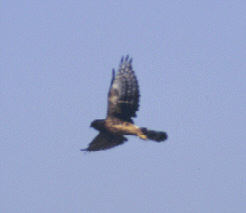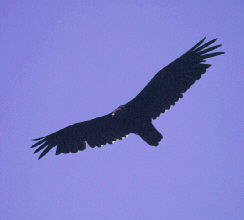PREDATORS AND SCAVENGERS
This group includes the raptors (hawks, eagles, and falcons) that prey on other birds, small mammals, insects, reptiles and other animals that live in wetland environments. This group also includes the vultures that feed on carrion (dead animals).
Circus cyaneus
L: 17-22" W: 38-47"
This raptor is commonly seen flying low over marshes and adjacent fields. Its wings are vertical. The female is various shades of brown with brown streaking on the breast, belly, and sides. The male is gray above and lighter in color below with streaking on the breast, belly, and sides. Both sexes are distinguished from other raptors by their long narrow wings and tail and a distinctive white rump.

Buteo jamaicensis
Cathartes aura
L: 27" W: 69"
A large soaring bird with a featherless red head. The underside of the wings are two toned. When in flight, the wings are held at an elevated angle above the body plane (dihedral). Commonly found above many different habitats where it searches for carrion.

Falco sparverius
L: 11" W: 23"
A small falcon with pointed wing tips and long tail. A rusty colored back and tail are found on the male. The blueish grey wings are also a sign of the male bird with their two black stripes on a white face. The females are all the same type of rusty color. Common in open area and often seen hovering above potential prey of insects, reptiles and small mammals.